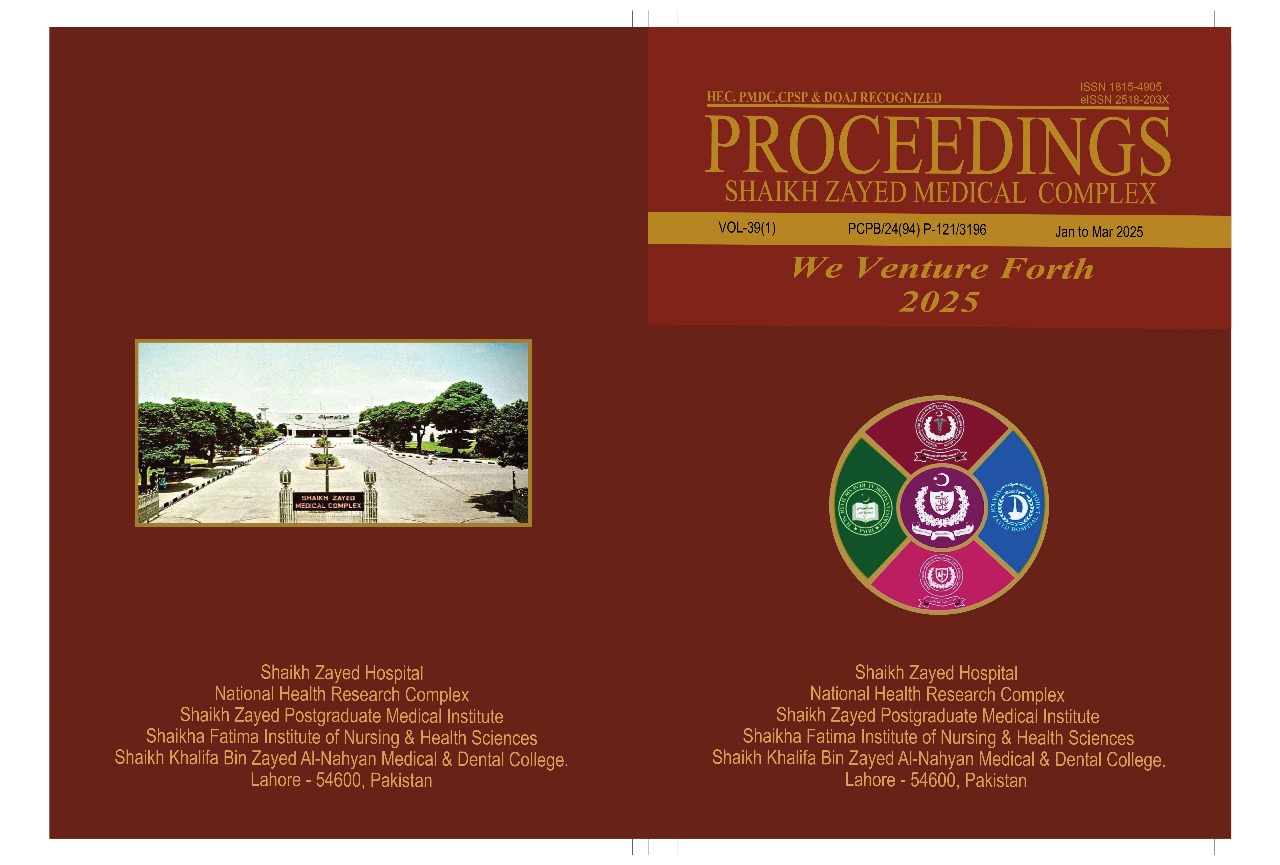Recombinant Irisin Ameliorates Insulin Resistance in Type 2 Diabetic Mice
DOI:
https://doi.org/10.47489/szmc.v39i1.476Keywords:
Irisin, insulin resistance, oxidative stress, diabetes mellitus type 2Abstract
Introduction: An exercise-induced myokine, Irisin, is shown to cause the browning of white adipose tissue, promote glycogen storage, and inhibit glucose and cholesterol formation in the liver. Studies have, however, shown a reduction of circulating irisin in type 2 diabetes, suggesting altered secretion of myokines in the setting of insulin resistance.
Aims & Objectives: This study explored the effect of recombinant irisin on insulin resistance and oxidative strain in laboratory induced type 2 diabetic mice.
Place and Duration of Study: Animal House and Laboratory of Akhter Saeed Medical and Dental College, Lahore from March 2018 to December 2018.
Material & Methods: A randomized comparative trial was conducted. Type 2 diabetes mellitus was produced in 60 male albino mice by feeding them a fat rich diet (60% kcal fat) for 6 weeks, followed by low dose streptozotocin (40 mg/kg body weight). Thirty diabetic mice acted as diabetic controls and thirty mice were administered recombinant irisin intra-peritoneally, 1mg/kg body weight daily for 4 weeks. Serum fasting glucose, insulin, lipid profile, and malondialdehyde were estimated thereafter. Insulin resistance was predicted by employing the HOMA-IR score and triglyceride-HDL ratio. The data was analyzed by using SPSS (version 21), a p value less than 0.05 was regarded statistically significant
Results: Diabetic mice that received recombinant irisin showed significant (p=0.000) reduction in fasting blood glucose (249.03±66.17mg/dl) and serum insulin (4.61±0.08µU/L) as compared to the diabetic control mice (428.50±78.13 mg/dl, 5.95±0.72µU/L). The degree of insulin sensitivity as determined by HOMA-IR score and triglyceride HDL ratio was significantly increased in the diabetic irisin groups as compared to the diabetic control group. This correlated with reduction in the oxidative stress marker malondialdehyde.
Conclusion: Recombinant Irisin improved insulin sensitivity and reduced oxidative strain in type 2 diabetic mice.
References
Azeem S, Khan U, Liaquat A. The increasing rate of diabetes in Pakistan: A silent killer. Ann Med Surg (Lond). 2022;79:103901. doi: 10.1016/j.amsu.2022.103901.
Wake AD. Antidiabetic Effects of Physical Activity: How It Helps to Control Type 2 Diabetes. Diabetes Metab Syndr Obes. 2020 Aug 19;13:2909-2923.doi: 10.2147/DMSO.S262289.
Boström P, Wu J, Jedrychowski MP, Korde A, Ye L, Lo JC, et al. A PGC1a dependent myokine that derives browning of white fat and thermogenesis. Nature. 2012;481:463–8.
Song R, Zhao X, Zhang D, Wang R, Feng Y. Lower levels of irisin in patients with type 2 diabetes mellitus: A meta-analysis. Diabetes Research and Clinical Practice. 2021;175:108788.doi: 10.1016/j.diabres.2021.108788
Laarens C, Bergouignan A, Moro C. Exercise- released myokines in the control of energy metabolism. Frontiers in physiology. 2020; 11:
Furman, B. L. Streptozotocin-induced diabetic models in mice and rats. Current Protocols. 2021; 1, e78. doi: 10.1002/cpz1.78
Chen HW, Yang MY, Hung TW, Chang YC, Wang CJ. Nelumbo nucifera leaves extract attenuate the pathological progression of diabetic nephropathy in high-fat diet-fed and streptozotocin-induced diabetic rats. J Food Drug Anal. 2019;27(3):736-748. doi: 10.1016/j.jfda.2018.12.009.
Duan H, Ma B, Ma X, Wang H, Ni Z, Wang B, et al. Anti-diabetic activity of recombinant irisin in STZ-induced insulin-deficient diabetic mice. Int J Biol Macromol. 2016;84:457–63.
Park S, Kim C, Wu X. Development and Validation of an Insulin Resistance Predicting Model Using a Machine-Learning Approach in a Population-Based Cohort in Korea. Diagnostics (Basel). 2022 Jan 16;12(1):212. doi:
3390/diagnostics12010212.
Chauhan A, Singhal A, Goyal P. TG/HDL Ratio: A marker for insulin resistance and atherosclerosis in prediabetics or not? J Family Med Prim Care. 2021 Oct;10(10):3700-3705. doi: 10.4103/jfmpc.jfmpc_165_21.
Aguilar Diaz De Leon, J., Borges, C. R. Evaluation of Oxidative Stress in Biological Samples Using the Thiobarbituric Acid Reactive Substances Assay. J. Vis. Exp. (159), e61122, doi:10.3791/61122 (2020).
Wang J, Zhao YT, Zhang L, Dubielecka PM, Zhuang S, Qin G, Chin YE, Zhang S, Zhao TC. Irisin Improves Myocardial Performance and Attenuates Insulin Resistance in Spontaneous Mutation (Leprdb ) Mice. Front Pharmacol. 2020 Jun 3;11:769. doi: 10.3389/fphar.2020.00769.
Yano N; Zhang L; Wei D; Dubielecka PM; Wei L; Zhuang S; Zhu P; Qin G; Liu PY; Chin YE; et al. Irisin counteracts high glucose and fatty acid-induced cytotoxicity by preserving the AMPK-insulin receptor signaling axis in C2C12 myoblasts. Am. J. Physiol. Metab 2020, 318, E791–E805.
Zhang D, Xie T, Leung PS.Irisin ameliorates glucolipotoxicity associated ?-Cell dysfunction and apoptosis via AMPK Signaling and Anti- Inflammatory Actions. Cell PhysiolBiochem. 2018; 51(2):924-937.doi: 10.1159/000495395.
Ye X; Shen Y; Ni C; Ye J; Xin Y; Zhang W; Ren Y Irisin reverses insulin resistance in C2C12 cells via the p38-MAPK-PGC-1a pathway. Peptides 2019, 119, 170120.
Liu C, Zhou J, Xu Y, Gong S, Zhu Y, Zhang H, Dong Y, Zhao B, Li X. Irisin Ameliorates Oxidative Stress-Induced Injury in Pancreatic Beta-Cells by Inhibiting Txnip and Inducing Stat3-Trx2 Pathway Activation. Oxid Med Cell Longev. 2022 Sep 6;2022:4674215. doi: 10.1155/2022/4674215.
Downloads
Published
How to Cite
Issue
Section
License
Copyright (c) 2025 Proceedings

This work is licensed under a Creative Commons Attribution 4.0 International License.


 This work is licensed under a
This work is licensed under a 